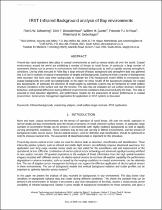JavaScript is disabled for your browser. Some features of this site may not work without it.
- ResearchSpace
- →
- Research Publications/Outputs
- →
- Conference Publications
- →
- View Item
| dc.contributor.author |
Schwering, PBW

|
|
| dc.contributor.author |
Bezuidenhout, DF

|
|
| dc.contributor.author |
Gunter, WH

|
|
| dc.contributor.author |
Le Roux, FPJ

|
|
| dc.contributor.author |
Sieberhagen, RH

|
|
| dc.date.accessioned | 2009-03-06T11:11:48Z | |
| dc.date.available | 2009-03-06T11:11:48Z | |
| dc.date.issued | 2008-04 | |
| dc.identifier.citation | Schwering, PBW, Bezuidenhout, DF, Gunter, WH, Le Roux, FPJ and Sieberhagen, RH. 2008. IRST infrared background analysis of bay environments. Infrared Technology and Applications XXXIV: Proceedings of SPIE, Vol 6940, pp 69401E. | en |
| dc.identifier.issn | 0277786X | |
| dc.identifier.uri | http://hdl.handle.net/10204/3147 | |
| dc.description | Copyright: 2008 Proceedings of SPIE | en |
| dc.description.abstract | Present-day naval operations take place in coastal environments as well as narrow straits all over the world. Coastal environments around the world are exhibiting a number of threats to naval forces. In particular a large number of asymmetric threats can be present in environments with cluttered backgrounds as well as rapidly varying atmospheric conditions. During trials executed in False Bay a large amount of target, background and atmosphere data was gathered that is of use in analysis of optical characteristics of targets and backgrounds. During the trials a variety of backgrounds were recorded. The authors have used these backgrounds to validate the TNO background model MIBS to incorporate also coastal backgrounds and sunlit sea backgrounds. In the paper they show results of the background analysis, for coastal bay backgrounds. In particular the detection of small targets by automatic system may be hampered by small surface structure variations at the surface and near the horizon. The data that the authors have analyzed are sea surface structure, temporal behaviour, and spectral differences during different environmental conditions that occurred during the trials. This data is essential to feed detection algorithms, and performance models for the assessment of sensor performance in coastal environment. Some sensor management approaches for application in IRST systems is discussed | en |
| dc.language.iso | en | en |
| dc.publisher | SPIE | en |
| dc.subject | Infrared backgrounds | en |
| dc.subject | Coastal bay analysis | en |
| dc.subject | Small surface target contrasts | en |
| dc.subject | IRST application | en |
| dc.title | IRST infrared background analysis of bay environments | en |
| dc.type | Conference Presentation | en |
| dc.identifier.apacitation | Schwering, P., Bezuidenhout, D., Gunter, W., Le Roux, F., & Sieberhagen, R. (2008). IRST infrared background analysis of bay environments. SPIE. http://hdl.handle.net/10204/3147 | en_ZA |
| dc.identifier.chicagocitation | Schwering, PBW, DF Bezuidenhout, WH Gunter, FPJ Le Roux, and RH Sieberhagen. "IRST infrared background analysis of bay environments." (2008): http://hdl.handle.net/10204/3147 | en_ZA |
| dc.identifier.vancouvercitation | Schwering P, Bezuidenhout D, Gunter W, Le Roux F, Sieberhagen R, IRST infrared background analysis of bay environments; SPIE; 2008. http://hdl.handle.net/10204/3147 . | en_ZA |
| dc.identifier.ris | TY - Conference Presentation AU - Schwering, PBW AU - Bezuidenhout, DF AU - Gunter, WH AU - Le Roux, FPJ AU - Sieberhagen, RH AB - Present-day naval operations take place in coastal environments as well as narrow straits all over the world. Coastal environments around the world are exhibiting a number of threats to naval forces. In particular a large number of asymmetric threats can be present in environments with cluttered backgrounds as well as rapidly varying atmospheric conditions. During trials executed in False Bay a large amount of target, background and atmosphere data was gathered that is of use in analysis of optical characteristics of targets and backgrounds. During the trials a variety of backgrounds were recorded. The authors have used these backgrounds to validate the TNO background model MIBS to incorporate also coastal backgrounds and sunlit sea backgrounds. In the paper they show results of the background analysis, for coastal bay backgrounds. In particular the detection of small targets by automatic system may be hampered by small surface structure variations at the surface and near the horizon. The data that the authors have analyzed are sea surface structure, temporal behaviour, and spectral differences during different environmental conditions that occurred during the trials. This data is essential to feed detection algorithms, and performance models for the assessment of sensor performance in coastal environment. Some sensor management approaches for application in IRST systems is discussed DA - 2008-04 DB - ResearchSpace DP - CSIR KW - Infrared backgrounds KW - Coastal bay analysis KW - Small surface target contrasts KW - IRST application LK - https://researchspace.csir.co.za PY - 2008 SM - 0277786X T1 - IRST infrared background analysis of bay environments TI - IRST infrared background analysis of bay environments UR - http://hdl.handle.net/10204/3147 ER - | en_ZA |






